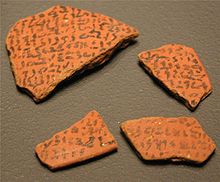Prohibition text
As execration texts is called hieratic and hieroglyphic inscriptions on ancient Egyptian pottery and clay figures that were partly labeled with different, sometimes warring with combined lists to name people, cities and countries in order to overthrow this ritual. In this way, they are also an important source of information on the political and linguistic conditions in Palestine and Nubia .
origin
The condemnation texts come from the Old and Middle Kingdom , some also from the period afterwards. It is unclear on whose behalf the condemnation texts were produced. However, since these are texts that are directed against enemies, mainly the military should come into question.
Locations
The oldest execration texts were in several pottery at four locations around the Great Pyramid at Giza found and date back to the 6th Dynasty (about 2347 to 2216 v. Chr.). They contain numerous Egyptian and Nubian personal names as well as some well-known Nubian peoples names.
Another group of ostracism texts comes from the earlier 12th dynasty (approx. 1938–1759 BC) and is written on clay vessels; a somewhat younger group is written on clay figurines, other texts of condemnation from the Middle Kingdom come from Mirgissa . The texts from the Middle Kingdom name Nubian princes, Canaanite cities with their princes, etc. a. Jerusalem , as well as the Egyptian deceased.
literature
- AM Abu Bakr / Jürgen Osing : Prohibition texts from the Old Kingdom. In: Communications from the German Archaeological Institute, Cairo Department. Vol. 29, von Zabern, Mainz 1973 (publication by a group from Gizeh), pp. 97 ff and panels 31–61.
- Wolfgang Helck : The relations of Egypt to the Middle East in the 3rd and 2nd millennium BC Chr. (= Egyptological treatises. Volume 5) Harrassowitz, Wiesbaden 1962.
- Yvan Koenig : Les textes d'envoûtement de Mirgissa. In: Revue d'égyptologie Volume 41, Paris 1990 (Auschtungstexte aus Mirgissa), pp. 101–125.
- Jürgen Osing: Prohibition texts from the Old Kingdom (II). In: Mitteilungen des Deutschen Archäologische Institut, Kairo Department, Volume 32, von Zabern, Mainz 1977 (publication by a group from Gizeh), pp. 133–185 and panels 40–51.
- Georges Posener : Princes et Pays d'Asie et de Nubie. Textes hiératiques sur des figurines d'envoûtement du Moyen Empire. Brussels 1940 (Younger Texts of the 12th Dynasty).
- Georges Posener: Prohibition texts. In: Wolfgang Helck (Hrsg.): Lexikon der Ägyptologie (LÄ). Volume I, Harrassowitz, Wiesbaden 1975, ISBN 3-447-01670-1 , Sp. 67-69.
- Kurt Sethe : The ostracism of hostile princes, peoples and things on ancient Egyptian clay pot shards of the Middle Kingdom. (=: Treatises of the Prussian Academy of Sciences. 1926, philos-histor. Class No. 5) Berlin 1926 (older condemnation texts from the 12th dynasty).
- Christoffer Theis: New suggestions for identifying the prohibition texts of the Middle Kingdom. In: Journal of the German Palestine Association. (ZDPV) Volume 128, Issue 2, 2012, pp. 121-132.
Web links
- Clay figure with condemnation text (drawing) on: fontes.lstc.edu ; last accessed on August 2, 2016.
- Christoffer Theis: Prohibition texts . In: Michaela Bauks, Klaus Koenen, Stefan Alkier (Eds.): The Scientific Biblical Lexicon on the Internet (WiBiLex), Stuttgart 2006 ff.

